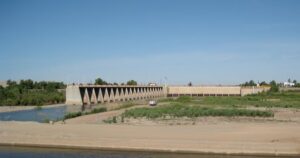
Morelos Dam, April 2010, by John Fleck
April 20, 2010, I took a drive that changed my life.
Around the back of the U.S. Bureau of Reclamation’s Yuma Area Office, helped by a map hand-drawn by Jennifer McCloskey, then the Yuma Area Office manager, I headed up a dirt road onto the levee that borders the eastern edge of the Colorado River as it makes its way south between the United States and Mexico.
Later that day, I headed north to Las Vegas. Always the storyteller in search of an angle, I walked after dark up to the strip to see the Bellagio Fountain. Here’s how I described it in a blog post time-stamped at 10:43 p.m. that evening:
LAS VEGAS, NEV – The distance between Morelos Dam on the lower Colorado and the Bellagio Fountain is profound. Morelos spans the U.S.-Mexico border, with the wheat fields and onions of the Yuma County Water Users Association behind me as I took this picture and Algodones on the far bank. Most years, Morelos is where the Colorado River effectively finishes its now futile run to the sea….
After some more stops to see the Lower Colorado’s plumbing, I made a beeline for Las Vegas. The contrast could not have been more stunning – up through the Sonoran and Mojave deserts, all mesquite and creosote, with occasional glimpses of the river strip in the distance, then through a ridge in the mountains, from quiet desert to this….
It is followed by the first of the umpty pictures I have taken in the years since of the Bellagio Hotel’s fountains as I returned again and again over the years to both places trying to make sense of the distance between the two.
Here is how I described that first levee drive in Water is For Fighting Over, the book that grew from the seeds planted on that April 20, 2010 drive:
Driving the Yuma County levee past Morelos Dam in 2010, I saw the last trickles of water from leaks in the dam and a shallow water table disappear within a few miles into a sandy, dry channel. This great river, the Colorado, around which I have spent much of my life, whose water I have showered with and drunk, which has grown the food I eat and floated my boats for hundreds of miles, simply disappears into the desert sand.
Storytelling as a vocation carries risk – the risk that a story often enough told becomes a substitute for the thing beneath it. Such is my story about Jennifer McCloskey’s map and my drive down the levee that spring morning. We hope that our bearing of witness is true to the thing, but it is always different than the thing. I wrote about this a year later in another context:
There’s an odd sort of detachment in the act of bearing witness for posterity instead of simply being in the moment. I know it professionally. I’m not a photographer, but I’ve been rethinking this because I’ve started taking pictures in my newspaper work recently. That fundamentally changes what has always been, for me, the act of bearing witness. Being at a “thing” when I’m working is different, the way I try to see more, remember and annotate and prepare for the retelling even as I’m experiencing. Instead of just being there and enjoying.
That trip to Yuma back in the spring of 2010 was my first attempt to learn the things I needed to bear witness to the Colorado River. I view this, still, as a work in progress.

Distance, chronological and otherwise, is so…what would we do without it? – Scot